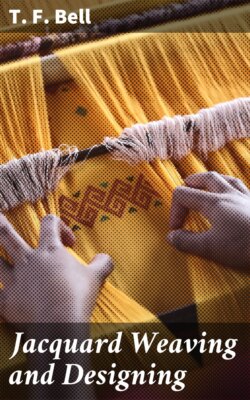Читать книгу Jacquard Weaving and Designing - T. F. Bell - Страница 6
На сайте Литреса книга снята с продажи.
CROSS’S COUNTERPOISE HARNESS
ОглавлениеTable of Contents
About the year 1816 Mr. James Cross, of Paisley, invented a machine to do away with the drawboys.
Fig. 6
This machine is fully described by Murphy and Gilroy in their works on weaving. Only the general principle of it will be given here, as an introduction to the jacquard. The detail of drawing the lashes and treading, though ingenious, is not of any practical importance now, and it requires rather a lengthy description to explain it. The harness F is the same as in the common draw loom till it reaches the tail cords, where the counterpoise apparatus commences. The framing B B (Fig. 6) of this machine is supported by the carriage A A, which rests on the capes or top rails of the loom. In this frame are two boards, C and D, perforated with holes corresponding in number with the tie of the harness or cords in the simple. The top board is called the suspension board, and is mortised into the bar E. From this board the harness hangs, the neck being taken up through the holes in it, and fastened above them. The lower board, D, which is mortised into the bar G, is called the neck board, or directing board, as it keeps the harness in its proper place. H and K are two other boards, perforated as shown in Fig. 7, mortised into the sliding bars I and L respectively; these are called the trap boards, M, M and N, M are four bars, called pushers, which are fastened to the sliding bars I and L as well as to the pulleys P, P, and when the pulleys are oscillated by means of a treadle the sliding bars will be moved up and down. The knot cords or tail cords O, O are fastened to the suspension board C, and pass through the two trap boards, then through the neck board, and are tied to the harness. Only two of these cords are shown tied to the harness, to avoid confusion. These knot cords have knots or beads on them as shown, and the round holes in the trap boards H and K, as shown in Fig. 7, must be sufficiently large (about ¼ in. in diameter) to allow the knots or beads to pass freely through. There are notches or saw-cuts at the sides of the holes to admit the cords, but support the knots. T, T1 is the simple, extending horizontally through the knot cords. It is fastened to the ceiling beyond T, and to the frame of the machine beyond T1. S is a half-leaf of heddles for the purpose of supporting the simple cords. Each simple cord is tied to a knot cord, and beyond T1 the simple is lashed according to the pattern. In working the machine the lashes are drawn by means of hooked levers, wrought by a treadle connected with the pulley V, and those simple cords that are drawn down pull the knot cords into the notches or saw-cuts in the trap boards, so that when the trap board is raised the harness fastened to those knot cords that are drawn into the saw-cuts will also be raised. R is a set of cords with weights on their ends for the purpose of drawing the knot cords out of the saw-cuts as soon as the simple is released by the lashes. The two trap boards rise and fall alternately, and this is why the machine is called a counterpoise.
Fig. 7
Some time after an improvement was made upon this machine which was known as
